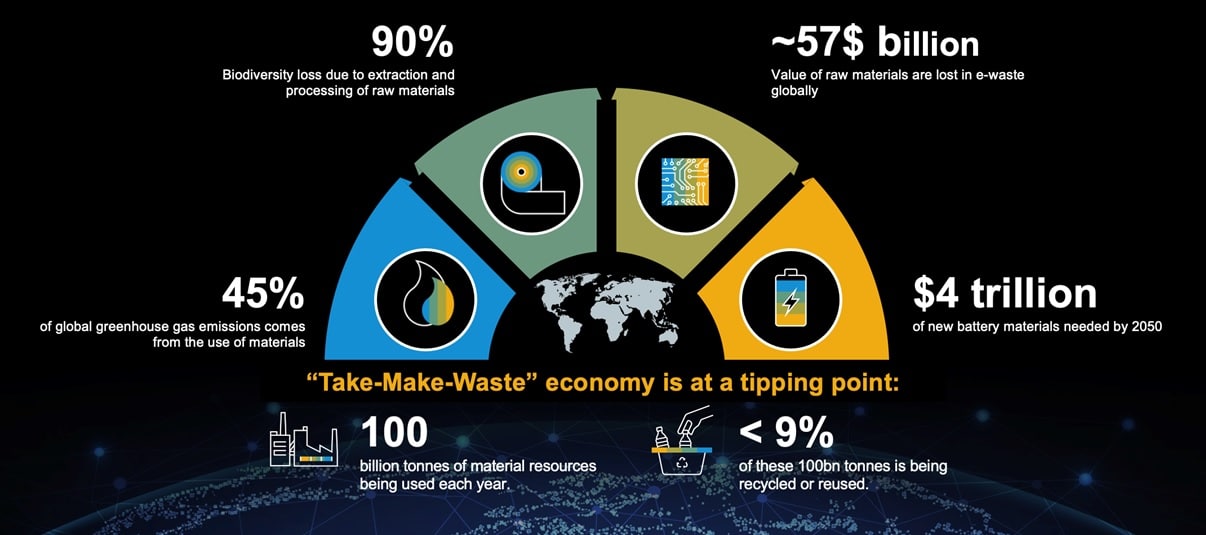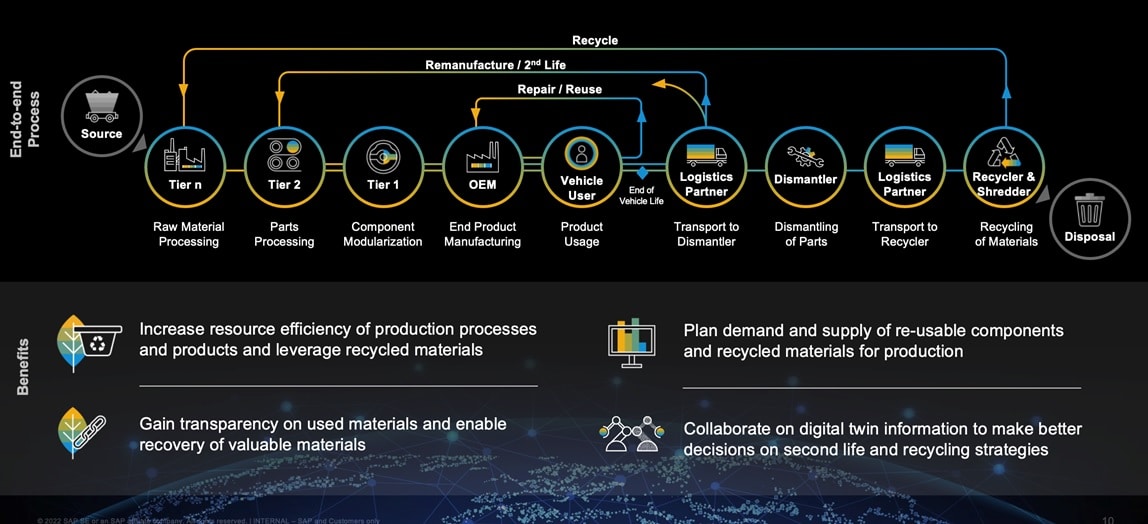In the traditional “take-make-waste” economy, materials flow in a linear way — from resources extraction to manufacturing and then to waste after usage. The automotive industry is responsible for a large share of resource consumption, especially steel, aluminum, plastic, rubber, and glass, among others.
The industry generates about five percent of industrial waste in the entire world,* and with increasing demand for electric vehicles (EVs), battery material consumption grows significantly.
Circularity is the key in order to tackle the environmental challenges by maximizing the value retention throughout the entire life cycle of products and materials. At the same time, the use of secondary materials avoids excessive use of finite natural resources and minimizes waste at a vehicle’s end of life while also reducing emissions from their manufacturing process.
According to the Ellen MacArthur Foundation, the implementation of circular business practices could save to 45% of carbon emissions and 90% of wasted materials. More than that, by implementing a data-driven “R-strategy” (reuse, remanufacturing, recycling), a circular economy does not only help enterprises meet their sustainability goals but also generate new business opportunities for the industry.

How Can Industry Network Enable the Circular Economy?
As SAP Chief Marketing & Solutions Officer Julia White shared in Reimagining an Industry-Wide Paradigm Shift Toward a Circular Economy, technology offers the most effective way to achieve circularity at scale.
Enterprises that are undergoing the digital transformation leverage technology to eliminate surplus in their own operation. However, a shift toward the circular economy cannot be achieved within one’s own business boundaries, but through a collaborative approach across the entire ecosystem.
To realize this vision, Catena-X — as frontrunner for the automotive industry in Europe — aims to bring all business partners, including multi-tier suppliers, original equipment manufacturers (OEMs), and recycling service providers, into one network to help ensure an open, secure, and interoperable data exchange along the value chain.

The transparency of data within the network helps to gain visibility into the complete material flow of a product life cycle, from “cradle to grave.” Utilizing information available in shared digital twins improves decision making of end-of-life vehicles, thus useful parts can be circulated back for refurbishment or reuse, and valuable raw materials can be recycled in a more effective way.
Furthermore, access to carbon footprint data based on a standardized methodology along the supply chain enables network partners to identify decarbonization potential to achieve their sustainability goals.
Industry Network Solutions Empower Circular Economy in Automotive
With SAP Industry Network for Automotive packages, we are closing the loop within the automotive industry in a sustainable, data-driven, and comprehensive manner.
A digital twin of vehicles as well as their components is accessible in the network. Complemented with the traceability capabilities, manufacturers are able to track quality issues back to the root cause much more efficiently and precisely. Important product information, such as compliance certificates as well as CO2 emission data, flows through the supply chain in a secure way, which provides better insights into the sustainability performance based on real data and helps to identify carbon reduction potentials.
On the downstream side, usage data such as maintenance or state-of-health (SoH) of batteries can be aggregated and analyzed into the digital twin dashboard as well. Dismantling companies can leverage this analytical insight for purchase decision of end-of-life vehicles. Moreover, with additional information on material composition or dismantling guidance provided by suppliers and OEMs, the second-life decision for reuse, remanufacturing, and recycling are more data-driven and thus improves the circularity of materials.
This is not yet the whole story. Manufacturers in the automotive industry have a constant demand to recover their secondary materials for remanufacturing and refurbishment in order to be more flexible with regards to the supply chain disruption as well as to achieve the quota of recycled materials. At the same time, sellers such as car dismantling companies have supply to meet this demand but are struggling to sell their components and parts on a very fragmented market.
As a secondary marketplace, the Encore by SAP solution is enabling regenerative business processes and empowering the network members to close the loops and make circular economy a reality. The demand-driven enterprise trading platform provides a simplified way to offer and discover secondary materials and components with integration into back-end procurement or asset management solutions. The platform enables trading of aftermarket components, such as alternators or batteries, and is looking to expand into further areas, such as secondary materials — from aluminum to polyurethane — or production waste and scrap.
This is how SAP helps to close the loop and make circular economy a reality. Together with Catena-X, we will make a more sustainable, more resilient, and more efficient supply chain happen.
If you are curious about the amazing milestones we have achieved and our vision for the years to come, please visit us at Hannover Fair:
- Catena-X: Hall 8, Booth D24
- SAP: Hall 4, Booth D04
Hagen Heubach is global vice president and head of Industry Business Unit Automotive, and a board member of the Catena-X Automotive Network.
Heiko Flohr is senior vice president and head of Product Management SAP for Discrete Industries, and a member of Guidance Board for Catena-X Automotive Network.
*Simic V (2013) End-of-life vehicle recycling—a review of the state-of-the-art. Technical Gazette 20(2):371–380
**Source: Ellen MacArthur Foundation; Global Resources Outlook; World Economic Forum; Circularity Gap 2021; World Wide Fund for Nature
